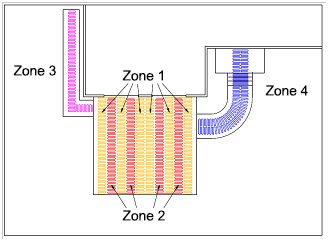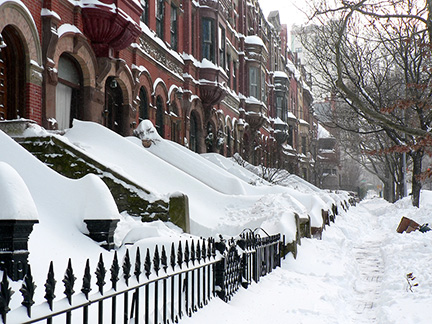Zoning Allows you to Enjoy the Benefits of Radiant Heat Using Minimal Power
Many homeowners are discouraged upon initially learning how much power it will take to operate the snow melting system of their dreams. But ProLine Radiant offers an effective solution that allows homeowners and businesses to install and operate a radiant heat system with limited amperage. Some hesitate to install a heated driveway system because they aren’t sure if they have enough amperage to power the system.
The performance and reliability of electric snowmelt systems can’t be beat, which is why they are the system of choice for so many homeowners. But after the initial assessment of their project by some radiant heat providers, some homeowners are discouraged to find that they lack the power to run a large snow melting system. But ProLine Radiant offers an innovative way to overcome the “lack of amperage” problem. By using a technique known as “zoning” (or staging), ProLine makes it possible to install and operate a large heated driveway system using minimal power (amps). This industry leading solution to power constraints is both effective and highly efficient.
How Zoning Works
For example, a heated driveway is being installed, but only two 30-amp breakers are available to power the system. To overcome the hurdle of limited power, the area to be heated is divided into zones. (See the corresponding illustration below, which shows the system divided into zones 1-4.) A snow sensor is installed in every zone, and the same power source (breakers) is supplied to each zone.

The zones are then prioritized. Zone 1 is designated as the most important area which needs to be cleared first. Upon detecting snow, the sensor in Zone 1 signals the controller, activating the system and clearing the area of snow.
After Zone 1 has been cleared of snow the breakers then shift power to Zone 2. Zone 2 is then heated and subsequently cleared. With Zones 1 and 2 now clear of snow, the breakers shift power to Zone 3. After Zone 3 is cleared, Zone 4 is then powered.
Summary
To recap, the Zone prioritized as the most important is cleared first, using power from the two 30-amp breakers. After Zone 1 has been cleared, the power is then switched to the next zone. When the second zone has been cleared, the breakers send power to Zone 3, followed by Zone 4 and so on. By using ProLine Radiant’s innovative cycling system, an entire area to be heated can be powered by just two 30-amp breakers.
ProLine Radiant’s industry leading cycling system is extremely efficient because it utilizes a “smart” feature. For example, if the snow in Zone 3 happens to melt before the zone is activated, then there would be no need for that zone to energize. Using ProLine Radiant’s method, the sensor in Zone 3 would detect that there is no snow to melt, and therefore no power would be sent to the zone. This smart feature saves money by ensuring that the system operates only when needed.
Many other zoning systems on the market use timers to activate the zones. These systems cycle between zones according to set times, regardless whether a zone is clear of snow or not. Furthermore, in some cases the snow in Zone 1 may be partially melted, yet the timer dictates that power is to be switched to Zone 2, resulting in neither area being fully cleared. This scenario (using set times) can create much longer melt times and be very inefficient in terms of power usage. By using ProLine Radiant’s cycling system; you are assured of energy efficiency, and the priority area will always be melted.
You can always call ProLine Radiant at 866.676.9276 or visit us online for more information or installation support and service. At ProLine, we’ll work hard to provide you with the best custom snow melting system solution at the best price possible. Call 866.676.9276 today.
Brace for a Record-Breaking Winter
According to meteorologists and experts at the National Weather Service, the winter of 2014 could bring snowfall of epic proportions where citizens, especially those in the Northeast, “will see snow like they never have in their lives.” Certainly this is a good time to have a radiant snow melting system installed, but the preparation runs much deeper than radiant heat.

Given the technological advancements in weather forecasting, meteorologists are boldly predicting that there is a 99 percent chance of a massive cold-front hitting the U.S. as soon as early October – sooner in the year than has ever happened. Starting from the first early winter blast record-breaking snow storms are expected to affect nearly all of the United States. Meteorologists are even suggesting that U.S. residents in some areas could see up to 50 times the amount of snow compared to years past. The Northeast, Ohio Valley, and the Midwestern states are expected to get hit the hardest.
With early snowfall (predicted to arrive as soon as early October), the average accumulative snow for the 2014 season could be five to ten times that of normal. Needless to say, this is the type of winter that Americans need to prepare for. Edward F. Blankenbaker, Senior Administrator of Meteorologists, told the media that this year will likely be a once-in-a-lifetime kind of snowy winter.
“Pretty much everyone will see snow like they never have in their lives. Most younger people don’t even know what an actual blizzard looks like, but by the end of March, they will be seasoned survivalists,” Blankenbaker said.
Naturally, a radiant snow melting system can be one asset when it comes to combating heavy snow storms, but having a heated driveway and/or walkways is just a small part of the solution. Americans will need to plan accordingly and stock their vehicles with weather emergency kits.
In addition to the impending severe winter weather, the Food and Drug Administration (FDA) predicts supply and demand could cause shortages, causing the prices of some staples like bread and milk to increase substantially. FDA spokesperson Rebecca Miller suggests alternatives in preparation of the coming months.
“We are encouraging that you go out and purchase bulk amounts of dry, powdered milk which can be stored in your cupboards,” FDA spokesperson Rebecca Miller suggests. “This will prevent frantic trips to grocery stores and super markets as the onslaught of storms begin to fall upon your respected region.”
Public safety organizations are also encouraging consumers to prepare themselves for brutal winter conditions by obtaining the proper necessities. According to James Satterfield from the National Fire and Safety Advisory Board, preparation can save lives. “Don’t wait until temperatures plummet into a freeze; obtain cold weather clothing and footwear, including wool thermal socks. It is also crucial to have plenty of batteries, candles, weather radios, you name it. Get prepared, it’s coming.” Satterfield warned.
Miller further added, “Stock up on your powdered milk and fill your freezer with loaves of bread, because once the blankets of snow begin to fall, brave souls will confront the elements to raid stores of these products like some sort of scavenger hunt. Don’t be a part of the Snowpocolypse, it’s a dangerous battlefield of crazed-shopping and winter-bitten weather zombies.”
Take steps necessary to ease the pain of brutal winters and heavy snowfall. Heated driveways and snow melting systems keep your driveway and walks clear – even during record breaking snow storms like those predicted for the the winter of 2014. Call ProLine Radiant today at 866.676.9276.
